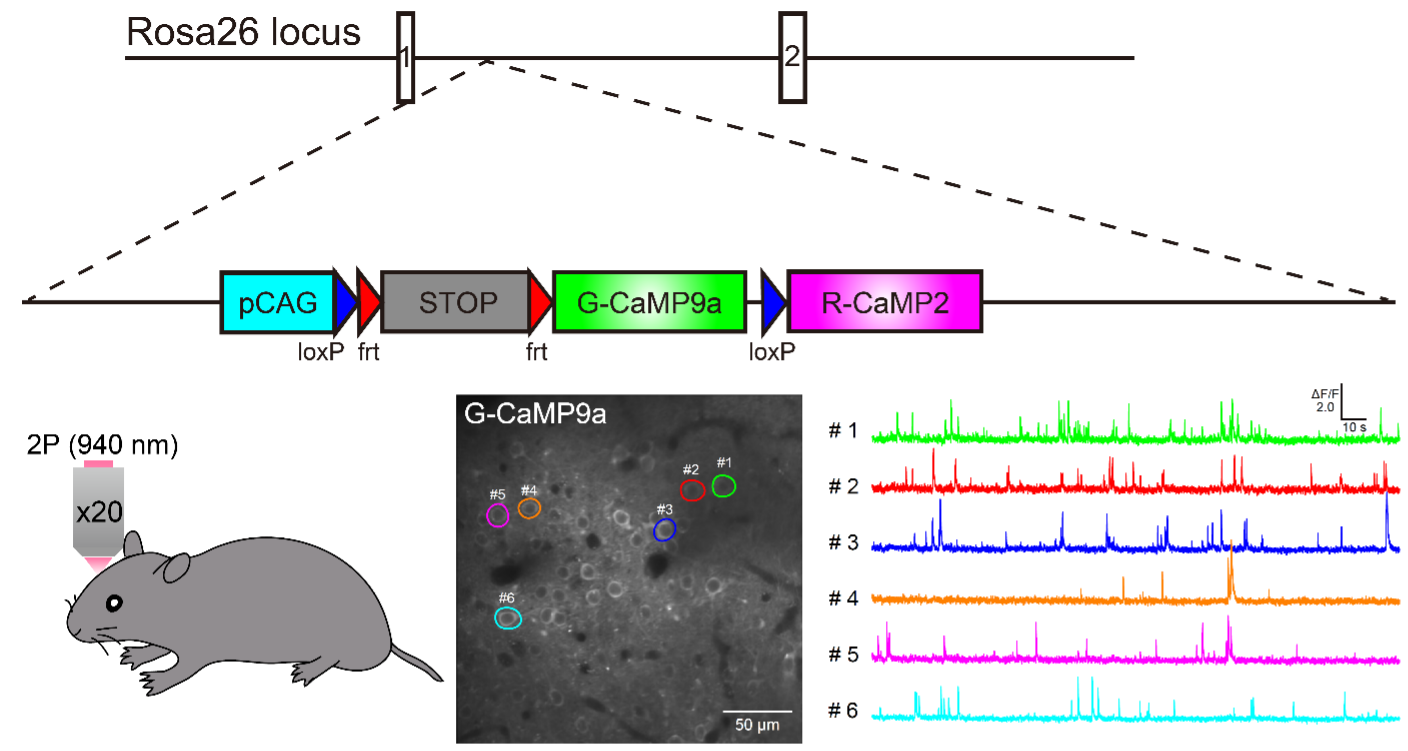 |
May 2023 Mouse of the Month |
|
Neuronal imaging in vivo with a novel calcium indicator G-CaMP9a C57BL/6N-Gt(ROSA)26Sor<tm1(CAG-G-CaMP9a,-R-CaMP2)Hbto> (RBRC11575)
|
| Accurate measurement of neuronal activity is essential for understanding complex higher brain functions such as cognition and learning. Recently, imaging technology based on fluorescent calcium indicators that use the influx of calcium ions into cells associated with nerve firing has attracted much attention. Dr. Bito and his colleagues developed a novel, highly sensitive and fast calcium indicator, G-CaMP9a. G-CaMP9a replaces the calcium-binding sequence M13 of the muscle-derived protein of conventional green calcium sensor G-CaMP4.1 with the calmodulin-binding region of calcium calmodulin-dependent protein kinase kinase (CaMKK). G-CaMP9a is characterized by fast kinetics and a high signal-to-noise ratio. They also generated a reporter mouse, G-CaMP9a KI mice (RBRC11575), which express G-CaMP9a under the control of CAG promoter in the ROSA26 locus [1]. In G-CaMP9a KI mice, it is possible to control G-CaMP9a expression using a tissue- or cell- specific Flp/FRT recombination system. In vivo imaging of neuronal activity in G-CaMP9a KI mice using a two-photon microscope has been reported to detect neuronal responses to sensory stimuli more accurately. A detailed protocol for the analysis method using G-CaMP9a KI mice has been published [2]. G-CaMP9a KI mice will be make a significant contribution to the neuroscience research as a tool for elucidating complex higher brain functions. |
| Keywords | : | Calcium imaging, Flp/FRT, G-CaMP9a, in vivo imaging, Fluorescent reporter | |
| Depositors | : | Haruhiko Bito, M.D., Ph.D. (The University of Tokyo) & Masayuki Sakamoto, Ph.D. (Kyoto University) | |
| Strain name | : | C57BL/6N-Gt(ROSA)26Sor<tm1(CAG-G-CaMP9a,-R-CaMP2)Hbto> | |
| RBRC No. | : | RBRC11575 | |
| References | : | [1] | Sakamoto M, Inoue M, Takeuchi A, Kobari S, Yokoyama T, Horigane SI, Takemoto-Kimura S, Abe M, Sakimura K, Kano M, Kitamura K, Fujii H, Bito H. A Flp-dependent G-CaMP9a transgenic mouse for neuronal imaging in vivo. Cell Rep Methods. 2022 Feb 14;2(2):100168. |
| [2] | Sakamoto M, Ota K, Kondo Y, Okamura M, Fujii H, Bito H. In utero electroporation and cranial window implantation for in vivo wide-field two-photon calcium imaging using G-CaMP9a transgenic mice. STAR Protoc. 2022 Jun 7;3(2):101421. |
||
| Related DNA resource | : | pBS-CaMKIIpro-G-CaMP9a-WPRE (RDB19172) | |
| May 2023 Saori Mizuno, Ph.D. Contact: Experimental Animal Division, RIKEN BioResource Research Center (animal.brc@riken.jp) All materials contained on this site may not be reproduced, distributed, displayed, published or broadcast without the prior permission of the owner of that content. |





